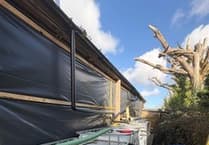RESIDENTS are being asked if they can help spot a beautiful bumble bee in steep decline across Cornwall.
Conservationists and local volunteers are searching for one of Cornwall’s most beautiful and rare bees – the Moss carder bumblebee – which is in steep decline. This summer conservationists have embarked on an extensive survey to learn more about its decline and ways to save it.
Once widespread in the UK, numbers of the rare Moss carder bumblebee are continuing to fall. The cause of its decline is complex but is often linked to the extensive loss of our well-connected flower-rich habitat.
Moss carder bumblebees have a beautiful bright ginger and golden yellow coat, but are very similar to some other species, such as the Brown-banded carder bumblebee and require close examination to positively identify.
Conservation charity the Bumblebee Conservation Trust, has recruited local volunteers and will be carrying out survey work this summer to gather vital information about this rare bumblebee by focusing on key sites where it has previously been recorded.
The Bumblebee Conservation Trust is a UK based charity that was established in 2006 due to serious concerns about the ‘plight of the bumblebee’. In the last century many bumblebee populations have crashed, and two species have become extinct in the UK.
The project aims to increase our understanding of the bumblebee’s ecology, abundance and distribution at its Cornish sites. We will be recording the distribution of individual bumblebees, their forage preferences and inhabited habitats; this knowledge will inform our conservation practices and hopefully help to reverse the Moss carder bumblebee’s decline.
Pip Cook, Southwest project officer for the Bumblebee Conservation Trust said "It’s so important we learn more about this rare bumblebee so that we can put in place appropriate conservation measures to save it. With two species already extinct in the UK, we don’t want populations of this bumblebee to lose any more ground.
“In addition to the sites already being searched, we are particularly interested in hearing from any budding naturalists who live near Kennack Sands and Cubert Common to volunteer their time this summer to help search for this rare bumblebee at these sites.”
Understanding how many of these rare bumblebees are present along the Cornish coast, which flowers they prefer to visit and where they like to nest, will help inform conservationists of the measures required to help protect them.
The search for this rare bumblebee species, is part of a national project which is visiting three of the most important areas for this bumblebee – Kent, Durham and Northumberland, and Cornwall. This national project is being delivered in partnership with Natural England who are responsible for ensuring that England's natural environment, including its flora and fauna, is protected and enhanced. The Cornwall population is at a critical moment and most at risk of being lost forever.
Whether a seasoned wildlife recorder, a regular conservation volunteer or someone with a little experience in insect identification, help from locals can make a real difference to ensuring accurate data collection and meaningful support for this rare bumblebee.


.jpeg?width=209&height=140&crop=209:145,smart&quality=75)


Comments
This article has no comments yet. Be the first to leave a comment.